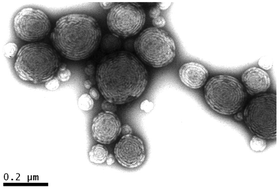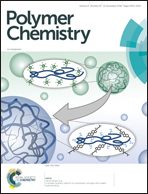Highly-ordered onion micelles made from amphiphilic highly-branched copolymers†
Abstract
Uniform onion micelles formed from up to ten nano-structured polymer layers were produced by the aqueous self-assembly of highly-branched copolymers. Highly-branched poly(alkyl methacrylate)s were chain extended with poly(acrylic acid) in a two-step reversible addition–fragmentation chain transfer-self-condensing vinyl polymerization (RAFT-SCVP) in solution. The resulting polymers were dispersed into water from oxolane (THF) using a self-organized precipitation-like method and the self-assembled particles were studied by phase-analysis light scattering, small-angle neutron scattering, and electron microscopy techniques. The relative hydrophobicity of the blocks was varied by changing the alkyl methacrylate (methyl, butyl, or lauryl) and this was found to affect the morphology of the particles. Only the poly(butyl methacrylate)-containing macromolecule formed an onion micelle structure. The formation of this morphology was observed to depend on: the evaporation of the good solvent (THF) during the self-assembly process causing kinetic trapping of structures; the pH of the aqueous phase; and also on the ratio of hydrophobic to hydrophilic segments within the copolymer. The lamellar structure could be removed by annealing the dispersion above the glass transition temperature of the poly(butyl methacrylate). To exemplify how these onion micelles can be used to encapsulate and release an active compound, a dye, rhodamine B (Rh B), was encapsulated and released. The release behaviour was dependent on the morphology of the particles. Particles formed containing the poly(methyl methacrylate) or poly(lauryl methacrylate) core did not form onions and although these materials absorbed Rh B, it was continuously released at room temperature. On the other hand, the lamellar structure formed from branch-poly(butyl methacrylate)-[poly(butyl methacrylate)-block-poly(acrylic acid)] allowed for encapsulation of approximately 45% of the dye, without release, until heating disrupted the lamellar structure.



 Please wait while we load your content...
Please wait while we load your content...